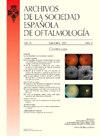传染病:流行病学、病因学、诊断结果和治疗
Q3 Medicine
Archivos De La Sociedad Espanola De Oftalmologia
Pub Date : 2025-07-01
DOI:10.1016/j.oftal.2025.01.010
引用次数: 0
摘要
感染性葡萄膜炎是一种葡萄膜的炎症,与眼睛的中间层相对应,是由对感染因子的反应引起的。这种情况分为前、中、后和全葡萄膜炎。前葡萄膜炎最常见的感染因子是病毒,主要是单纯疱疹病毒。但也可由其他病原体引起,如巴尔通体、结核分枝杆菌、镰刀菌等。中期葡萄膜炎以梅毒为主,后葡萄膜炎涉及多种微生物,如刚地弓形虫、巨细胞病毒、疟原虫、念珠菌等。在某些情况下,如眼弓形虫病,严重的炎症可累及整个葡萄膜,导致全葡萄膜炎。葡萄膜炎的临床表现包括眼痛、红肿、肌萎缩、视力模糊,甚至视力丧失。直接识别病原体是复杂的,现有测试的诊断性能差异很大。例如,聚合酶链反应(PCR)对眼部标本检测单纯疱疹病毒的敏感性为91.3%,特异性为98.8%,而对弓形虫病的敏感性为43.1%,特异性为98.5%。感染性葡萄膜炎的另一个挑战是治疗,因为全身抗菌剂对眼组织的渗透通常很低,大多数不到5%,主要是由于血液-视网膜和血液-水屏障。低蛋白结合和高脂溶性有利于分子在眼组织中的作用。本文综述了感染性葡萄膜炎最常见的细菌、病毒、寄生虫和真菌病因的临床表现,以及现有检测方法的诊断性能。此外,重点放在不同的治疗方法取决于病因。本文章由计算机程序翻译,如有差异,请以英文原文为准。
Uveítis infecciosa: epidemiología, etiología, rendimiento de pruebas diagnósticas y tratamiento
Infectious uveitis is an inflammation of the uveal tract, corresponding to the eye's middle layer, triggered by a response against an infectious agent. This condition is classified into anterior, intermediate, posterior and panuveitis. The most frequent infectious agents in anterior uveitis are viruses, mainly herpes simplex virus. However, it can also be caused by other pathogens such as Bartonella spp., Mycobacterium tuberculosis and Fusarium spp. In intermediate uveitis, syphilis plays a predominant role, while in posterior uveitis various microorganisms are involved, among them Toxoplasma gondii, Cytomegalovirus, Plasmodium spp. and Candida spp. In some instances, as in ocular toxoplasmosis, severe inflammation may involve the entire uvea, resulting in panuveitis.
Clinical manifestations of uveitis include ocular pain, redness, myodesopsias, blurred vision, and even vision loss. Direct identification of the causative agent is complex, and the diagnostic performance of available tests varies significantly. For example, polymerase chain reaction (PCR) on ocular specimens for Herpes simplex virus has a sensitivity of 91.3% and specificity of 98.8%, while for toxoplasmosis the sensitivity is 43.1% and specificity 98.5%. Another challenge in infectious uveitis is treatment, as systemic antimicrobials generally have a low penetration into ocular tissue, mostly less than 5%, mainly due to the blood-retinal and blood-aqueous barriers. The efficacy of the molecules in ocular tissue is favored by low protein binding and high liposolubility.
This review addresses the most frequent clinical manifestations of bacterial, viral, parasitic and fungal etiologies of infectious uveitis, as well as the diagnostic performance of available tests. In addition, emphasis is placed on the different therapeutic approaches depending on etiology.
求助全文
通过发布文献求助,成功后即可免费获取论文全文。
去求助
来源期刊

Archivos De La Sociedad Espanola De Oftalmologia
Medicine-Ophthalmology
CiteScore
1.20
自引率
0.00%
发文量
109
审稿时长
78 days
期刊介绍:
La revista Archivos de la Sociedad Española de Oftalmología, editada mensualmente por la propia Sociedad, tiene como objetivo publicar trabajos de investigación básica y clínica como artículos originales; casos clínicos, innovaciones técnicas y correlaciones clinicopatológicas en forma de comunicaciones cortas; editoriales; revisiones; cartas al editor; comentarios de libros; información de eventos; noticias personales y anuncios comerciales, así como trabajos de temas históricos y motivos inconográficos relacionados con la Oftalmología. El título abreviado es Arch Soc Esp Oftalmol, y debe ser utilizado en bibliografías, notas a pie de página y referencias bibliográficas.
 求助内容:
求助内容: 应助结果提醒方式:
应助结果提醒方式:


